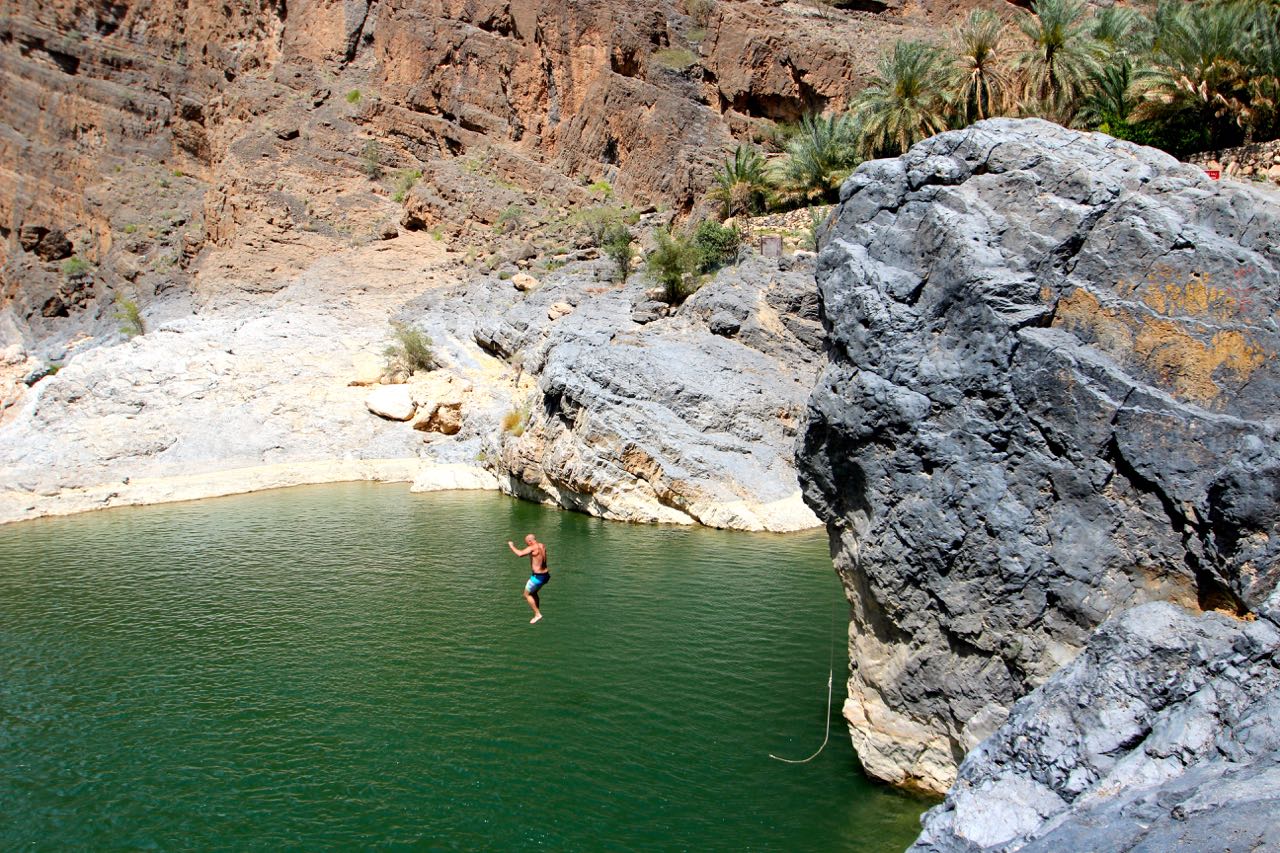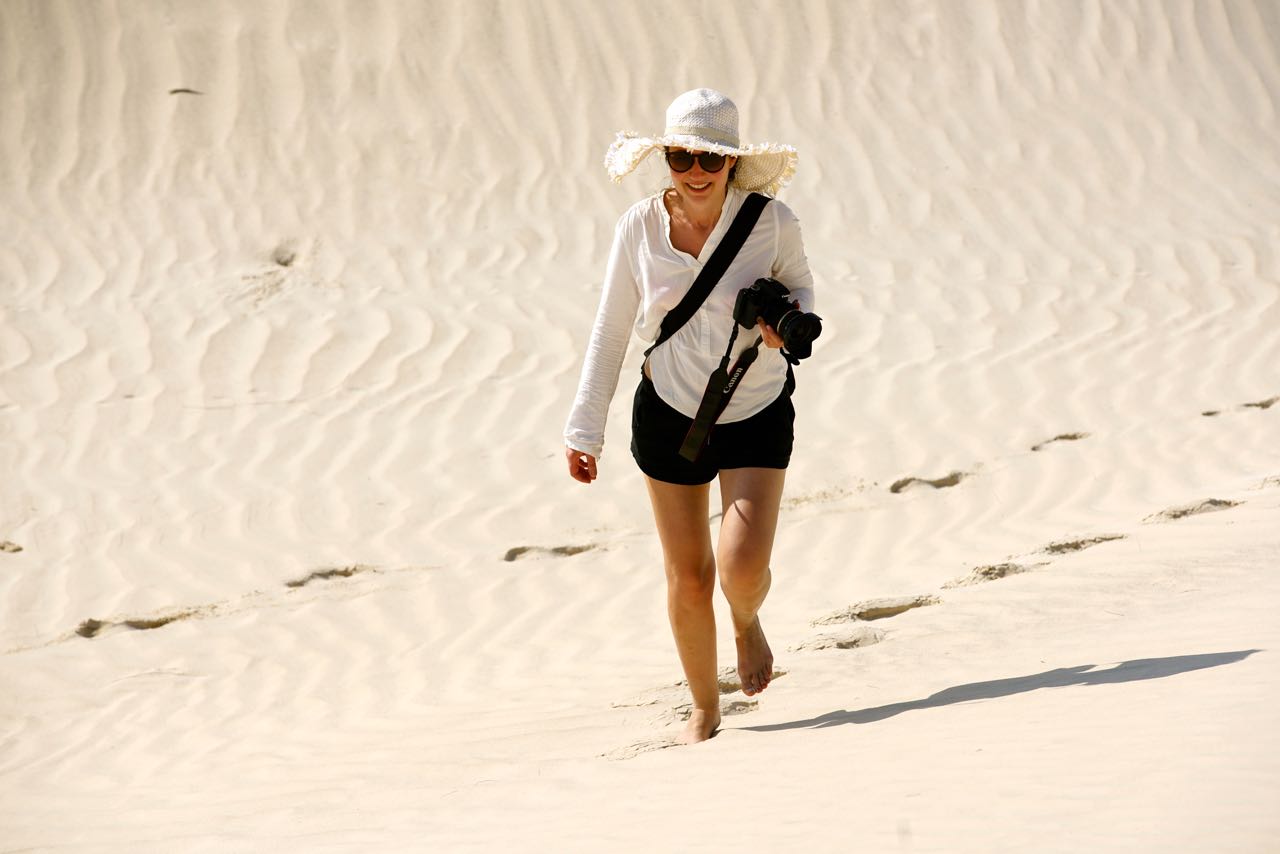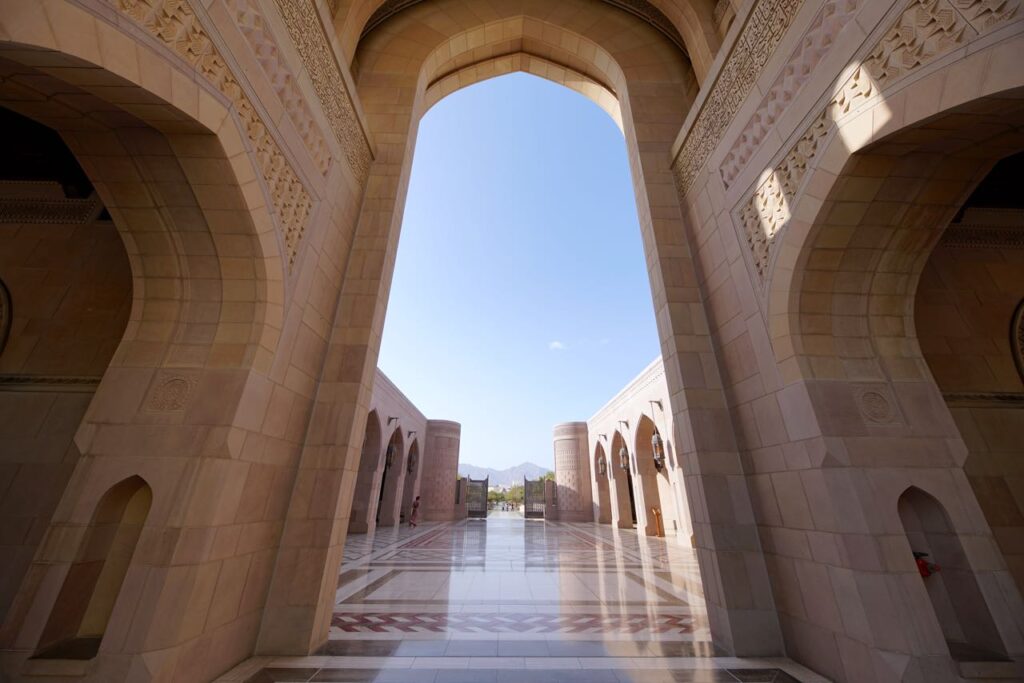After 80 days around the world… I landed in Muscat, the capital city of the Sultanate of Oman. For this last phase of my three-month-long trip, I am not prepared at all, but I do not have to be, Christiane took over and checked all the necessities.
 Christiane visited Oman in December 2016 for her first time and was fascinated ever since. She was impressed by the culture and the hospitality which came along with it and by the seemingly endless possibilities of exploration, either in the Persian ocean, the desert or the Al Hajar Mountains. Oman is sparsely inhabited and about 5 % of the population is still living as nomads. With a surface area of 309.500 km² and just a bit more than four million people, which are mainly living in the cities, there is plenty of space for adventures. Off-road driving is one of those possibilities which guarantees lots of fun while discovering the country. No matter if we are talking about the serpentines of the Al Hajar mountain range or driving to the snow white Sugar Dunes at Al Khaluf or through dry Wadis. Oman…. welcome to the world of frankincense. We booked a Toyota 4 x 4 which had all the needed camping equipment included (that makes real sense if you plan to sleep outside for most of the time). After getting through the papers right on the airport we left for our big outdoor and off-road adventure. But before we were leaving Muscat we planned to see the Sultan Qaboos Grand Mosque, the main mosque in Oman.
Christiane visited Oman in December 2016 for her first time and was fascinated ever since. She was impressed by the culture and the hospitality which came along with it and by the seemingly endless possibilities of exploration, either in the Persian ocean, the desert or the Al Hajar Mountains. Oman is sparsely inhabited and about 5 % of the population is still living as nomads. With a surface area of 309.500 km² and just a bit more than four million people, which are mainly living in the cities, there is plenty of space for adventures. Off-road driving is one of those possibilities which guarantees lots of fun while discovering the country. No matter if we are talking about the serpentines of the Al Hajar mountain range or driving to the snow white Sugar Dunes at Al Khaluf or through dry Wadis. Oman…. welcome to the world of frankincense. We booked a Toyota 4 x 4 which had all the needed camping equipment included (that makes real sense if you plan to sleep outside for most of the time). After getting through the papers right on the airport we left for our big outdoor and off-road adventure. But before we were leaving Muscat we planned to see the Sultan Qaboos Grand Mosque, the main mosque in Oman.

The mosque is one of the most important buildings in the country and one of the biggest in the world. Sultan Qaboos himself decided in 1992 the foundation of the Mosque, the commencement of construction started in 1995 and the big opening ceremonies took place in 2001. The whole complex is based on 300.000 tons of Indian sandstone and houses a huge variety of premises, including an enormous praying hall for men and a smaller one for women.
If you ask yourself why men have a much bigger praying hall the answer is, that women are allowed to pray at home (because of their children), men aren’t! The chandelier, one of the biggest in the world, measures 8 x 14 meters and has 1122 lamps. The shine and sparkle are guaranteed through the incredible crystals work by Swarovski – Austria … and the chandelier weighs eight tons! And no…. this is not the end of superlatives so let’s continue with the prayer mat, an Iranian masterpiece, which has been woven in single pieces and then darns into one huge wonderful carpet by the size of 70.50 x 60.90 meters! This praying mat adorns the praying hall of men, it is almost square and offers a place for 6500 believers!

We were mesmerized by the magical beauty of this mosque whose vibes touched us deeply. If you like to take some pictures make sure you are there in the early morning, just before they are opening up. This will give you the chance to get some great pics while nobody is strolling around (well at least for 15 minutes or so). The architecture is amazing and the charisma of the whole place moving… so let me invite you for a stroll through the mosque.

Impressed by the spectacular mosque and strengthened through fresh dates and Omani coffee we finally moved on towards the city of Sur, southeast of Muscat. The population of Muscat is about 30.000 (including the suburbs like Matrah, Ruwi, Qurum und Sib ) which are definitely worth a visit. We are driving along the coast and in this region, you can expect a subtropical climate with warm winters and hot summers. Do not be surprised if the temperature already reaches 40 °C at eight in the morning !!! The following sketch is a self-made simplified map from our Oman tour. It is meant to give you a better understanding and orientation for both blogs and mirrors our twelve day Toyota 4 x 4 off-road driving tour through Oman.

For a better understanding, I would like to mention why Oman is such a great place for off-road driving and outdoor adventures. The Sultanate of Oman has a spectacular mountain range, palm oases, the ocean and of course a huge playground… the deserts! So for those of you who love to drive by yourself and off-road you are in heaven, besides that the average price of gasoline is 0.35 cent ($ 0.40) per liter (April 2017). A real dream destination in the Orient: the Sultanate of Oman!
What really impressed me and where I would like to express my opinion about it is that you can camp for free, wherever you are in Oman. No matter if it is on or off the beach, beside the roads, the incredible mountain ranges or in any one of the desert regions !!! This is rarely seen, thanks to the Sultanate of Oman and my utmost respect for keeping this possibility up.

Our first off-road tour took us in the area of Wadi Al Arbiyyin, a rugged region abounding in water. At this point, I like to mention that the varied spelling in Oman can be (will be) often confusing in terms of finding your chosen place. Even on the internet, you will find a huge gape when it comes to spelling localities. The Wadi Al Arbaeen (وادي الـعـربـيـيـن) or Wadi Al Arabiyeen or Wadi Al Arabieen is a breathtaking landscape where you drive (or find) your way through rough terrain traversed by freshwater pools. A recommendation which is actually a necessity is the Oman-off-Road-Explorer book which Christiane organized beforehand. The topic and substance of the book are focused on detailed mapping, GPS data and 38 excellent described off-road tours. If you travel with a partner there is only one challenge… how to hold on to it because you just don’t want to lay it aside!

After a fantastic – refreshing swim and some small scouting expeditions, we moved on towards Hawiyat Najm Park where the village of Bamah is famous for the huge sinkhole, which can be found about 10 km north of the village. It is also called Dibab Sinkhole because it is right in the middle of both villages. The limestone of the crater surmises a natural depression which is 40 meters long and lays 20 meters above the sea level. The ocean itself is just a few hundred meters away from this impressive freshwater pool. The place is easily accessible and almost next to the road so don’t get surprised when it is crowded. We preferred to move on quickly.

Our Toyota keeps on rolling towards Sur. This town was once the most significant East African-harbour and the trade connections between Sur and East Afrika are dated back to the 6th century after Christ. But our target for today is far more south and so we drove till late at night towards Muhut, respectively Al Khaluf. The ‘White or Sugar Dunes’ attracted us already before we even set foot in Oman. We heard and saw so much about it, that we were impatient to get there and we also looked forward to the off-road drive. The following pictures show you parts of the journey towards Al Khaluf.


This route is spiked with geological, ornithological and zoological treasures… most of them undiscovered! The real exciting part on this off-road tour starts at Barr AL Hikman lagoon from where we drove to Filim and then continued through a great salt flat before reaching the white sandy beach of ‘Sugar Dunes’. The salt flat is a fantastic place to practice your off-road driving skills surrounded by a breathtaking scenery. My recommendation: Two or more vehicles (convoy) defiantly increase the fun and safety of this (all off-road) trip(s).

From the dried up salt flat, we continued through rolling sandy stretches till we reached the ocean. Once you reached the ocean navigation is easy. There is only one possible way and that is, driving along the emerald waters of the Persian Gulf, while you gasp for air because of the breathtakingly Sugar Dunes on the other side. As usual, by entering such isolated region, make sure you have enough water, gasoline, tires and tools etc. because out there you are (most of the time) by yourself.
At this point I like to recommend once more the Oman-off-Road-Explorer book because without it you probably don’t even find half of the tours, we didn’t. Through my off-road driving experience in Africa, I knew that I had to decrease the air pressure in the tires but I couldn’t find any hints or marks about it in the book or online when I came to driving in the deserts of Oman. I thought then that the underground obviously must be more solid than in Africa and so it was. Just certain areas, dunes and few other locations asked for such air pressure decrease. But we also had luck (several times) and so we had a fantastic mesmerizing time at a magical spot accompanied by silence and the different voices of the wind. A beautiful spot of nature, Sugar Dunes – Oman



Indescribable, immeasurable and unforgotten…
With a huge sandy dust cloud (seen through our back mirrors) and the food on the gas pedal, we finally left the Sugar Dunes and our Toyota was rolling again, this time towards Ras Markaz (which is between Ad Duqm and Ras Madrakah) the most southern point of our Oman trip. In general, the roads of Oman are in a superb condition, little traffic, top pavement and with a gasoline price of 0.35 cent ($ 0.40) a liter (April 20017) driving makes really fun!
Huge areas and parts of the coast between Duqm, Ras Markaz, and Ras Madrakah are highly polluted (mainly plastic). The whole industrial region(s) have little environmental regulations and even less monitoring. Unobserved from the world and having a ‘carte blanche’ the oil and fishing industry is the main cause of the pollution! If you look back (not even 20 years) you only found long beautiful stretches of sandy beaches and few fishing boats and at that time the ocean still had an abundance of fish. But this scene changed dramatically and today it is littered by plastic and where you saw, once upon a time, the local fishing boats you encounter now big fishing cutters and lots of cooling units right on the beach. Those units are meant for temporary storage before the huge amount of fish gets picked up by road trucks. It’s an oxymoron because fish get taken out of the ocean, stored in huge cooling units, then picked up by road trucks, driven hundreds of kilometer through desert terrain before it ends up on a market (in the same country !) or gets shipped overseas.
The stock of fish additionally gets weakened through illegal fishing and it is totally clear that the overfishing is leading to an ecological fiasco. An economic disaster and one-way street! It is not difficult to imagine that each family here originated sailors and fisherman but that memories seem to be forgotten! The ‘future of fish’ never looked sadder than today and therefore this following report is highly recommendable: World Ocean Review and Oman and the shark fishing industry

Actually, we had planned to put up our tent as usual, somewhere on a nice quiet stretch of the beach. A place where we can make a small campfire, look at the wonderful sky and breathtaking stars but… I just couldn’t !!! The pollution which surrounded us caused discomfort in such amount that I felt stirred up, sad and defiantly unwilling to spend a night here. So we turned around and drove late into the dark before we reached Duqm where we spend the night in a hotel. We still felt sad when we left early morning next day but Duqm was behind us and we focused on our next destination, Ibra.
We were excited than in two days we finally should be in the desert again, at the Nomadic Desert Camp – Rimal Al Wahiba/ Wahiba Sands. From Duqm to Ibra it is a 420 km long and (really) boring stretch through a stark, flat and dusty landscape. Hour by hour… no change whatsoever… till you finally recognize the first uprisings on the horizon. Just before reaching Ibra, Christiane used the opportunity of the landscape to refresh her off-road driving skills… that was our highlight on this long stretch of driving. We were really tired, languid and crumpled-up as we found a hotel just outside of Ibra which suited our condition! But for now… we just needed a shower and a good sleep because for the next day we had planned to visit the women’s market in Ibra.
Don’t worry, the women’s market is not a marriage market or even worse a slave market! It has nothing in common with that although Oman abolished slavery as late as 1970, as the last country in the world! The women’s market always takes place on a Wednesday and was established in the 90s-era from women for women.

The women’s market from Ibra is definitely unique for Oman and it extends to the municipal hospital from where it spreads out about half a kilometer. The Women’s Souq from Ibra is meant for women only but whilst our visit I saw that it was not seen so strictly. Anyway… I respected it and did not enter the women’s market (as you can see at the next pictures).
The Sultanate of Oman – a fairyland like in a book: A Thousand and One Nights by Alfred E. Green. But this fairyland has as much question marks like the title of the book! Without a doubt, it’s due to Sultan Qaboos for what he gained for his county in the past 40 years while he is leading it.
From ‘middle ages’ to modernism… from camel to Cadillac and what once began at the frankincense road, ends today at shopping malls.
Rihla saida, Maskat April 2017





























































